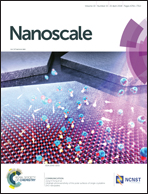Quantum-size effects in visible defect photoluminescence of colloidal ZnO quantum dots: a theoretical analysis†
Abstract
ZnO has been known for a long time to be a highly efficient luminescent material. In the last few years, the experimental investigation of the luminescent properties of colloidal ZnO nanocrystals in the nanometer range of sizes has attracted a lot of interest for their potential applications in light-emitting diodes and other optical devices and in this work we approach the problem from a theoretical perspective. Here, we develop a simple theory for the green photoluminescence of ZnO quantum dots (QDs) that allows us to understand and rationalize several experimental findings on fundamental grounds. We study the spectrum of light emitted in the radiative recombination of a conduction band electron with a deeply trapped hole and find that the experimental behavior of this emission band with particle size can be understood in terms of quantum size effects of the electronic states and their overlap with the deep hole. We focus the comparison of our results on detailed experiments performed for colloidal ZnO nanoparticles in ethanol and find that the experimental evolution of the luminescent signal with particle size at room temperature can be better reproduced by assuming the deep hole to be localized near the surface of the nanoparticles. However, the experimental behavior of the intensity and the decay time of the signal with temperature can be rationalized in terms of holes predominantly trapped near the center of the nanoparticles at low temperatures being transferred to surface defects at room temperature. Furthermore, the calculated values of the radiative lifetimes are comparable to the experimental values of the decay time of the visible emission signal. We also study the visible emission band as a function of the number of electrons in the conduction band of the nanoparticle, finding a pronounced dependence of the radiative lifetime but a weak dependence of the energetic position of the maximum intensity.



 Please wait while we load your content...
Please wait while we load your content...